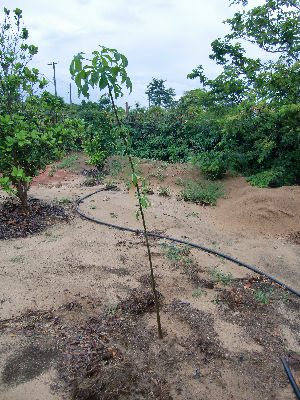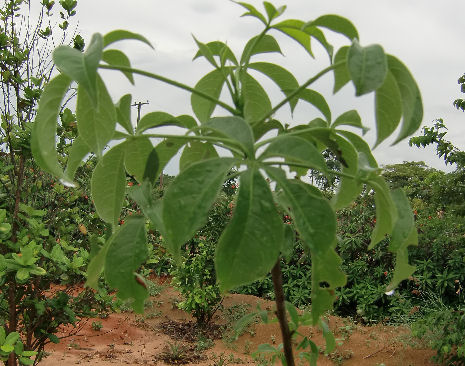

Adansonia digitata (African Baobab)
Huge tree from the dry savannas of Africa from the genus Malvaceae, could become very old and some thousand years old. The trunk is relatively short and could become to 33 feet (10 m) thick, therefore I have planted it as far as from my house. Frequently bottle shaped trunk forms occur and the tree can become 67 feet (20 m) tall.
The canopy is madeof strong, often appearing clumsy branches, which form a wide spreading crown. In the bleak state of the crown is reminiscent of a root system. One legend said that the baobab tree is a tree planted by the devil upside.
The trunk is often furrowed deep or shows throaty wells. The bark is gray-brown to gray and is between 2 inches (5 cm) and 5 inches (10 cm) thick. Therefore, the tree can survive small bush fires relatively unscathed. It is hard on the outside and inside fibrous. In youth it forms one tap root at first, later it develops one lateral root system, ranging up to (6 feet) 1.80 m depth. In the horizontal direction, the root system extends further than the tree height.
The baobab goes through four stages according to the trunk form. In the first phase (up to 10 - 15 years), it grows without a pronounced increase in thickness to a level approaching from 13 to 20 feet (4 to 6 meters), the branches extend upward at an acute angle. It grows relatively quickly in youth, at first from 3 to 4 feet (80 to 100 cm) per year. In this phase you will find our baobab, which was planted only on Dec. 3rd, 2010. In the second phase at the age of 60 - 70 years the base swells to a conical shape, is 17 to 50 feet (5 to 15 meters) high and up to 7 feet thick, the tree blooms and bears fruit for the first time beginning at the age of 30 to 40 years the branches of the tree to grow rectangular and take away much from that point in their length growth. The stem is thick and only slowly developed in the age of 200 to 300 years in a bottle shape. A tree may be the age of 100 years, when it has a trunk with diameter of 13 to 17 feet (4 to 5 meters). In the last phase, it developes a spreading crown and grows only very slowly in width. Often the trunks formed several times and also hollow when very old specimens of up to 800 years. In Africa, hollow stems are used as cattle sheds, grain storage, water storage and also for the burial.
The baobab tree throws its leaves in the dry season and resprouts shortly before the start of the rainy season again and the new leaves develop to fully develop within four weeks. If the dry season lasts longer, or it rains too few, it resprouts later.
At first leaves of a simple elliptical shape appear and are thrown off early again. Then follow the shiny green leaves, are the five- to nine-piece, see pictures below. They have a diameter of about 8 inches (20 cm) and are arranged alternate to the shoots.
The flowers are very large and waxy-white, and depend on long stalks from the axils of the leaves down, appear 4 weeks after the leaves appear. They consist of 5 petals that look a little overlap and approx. 2 inches (4.5 to 5 cm) wide and 5 inches (12 cm) long. Each flower has 720-1600 stamens that are joined at their base to a 0.6 to 1.8 inches (1.5 to 4.5 cm) long tube. The flowers smell unpleasant and spread a sweet smell of carrion, open late afternoon and are fully open in the early morning. They are pollinated by bats and moths.
After pollination pods develop from the long stems within 8 months, which reach a length of between 10 to 16 inches (25 to 40 cm). During maturation they change color from green to yellow to gray-brown. The fruits are edible for humans and are among the vitamin-richest fruits in the world, the baobab tree can therefore be used as a fruit tree. In particular, the white pulp is edible and tastes sour, is of a consistency that reminds about to solid, brittle wool from which the seeds can be broken out. The seeds are also edible, hazelnut large, kidney-shaped and very fatty.
The seeds remain viable for several years and have a strong dormancy that ends presumably by bush fires and prolonged rains in Africa, the dormant is stopped by feeding by elephants, digestion and excretion bring the seeds to germinate. Without pretreatment the germination amount will be only 20 percent and growing more difficult. It is facilitated only when the seeds are poured by boiling water over and kept around a day in the water, then the seeds will germinate after 3 weeks to 6 months. Also with acid treatment or grinding the seeds can be brought quickly to germinate.
The baobab is also grown in India. In Brasil it does find one suitable climate to thrive there well.

Our recently planted baobab on Dec., 3rd, 2010
in our yard.

Close-up view of the leaves of Adansonia digitata in December 2010.
Back to the Agricultural Plant List
Created by Joachim Jaeck on April, 2nd, 2011